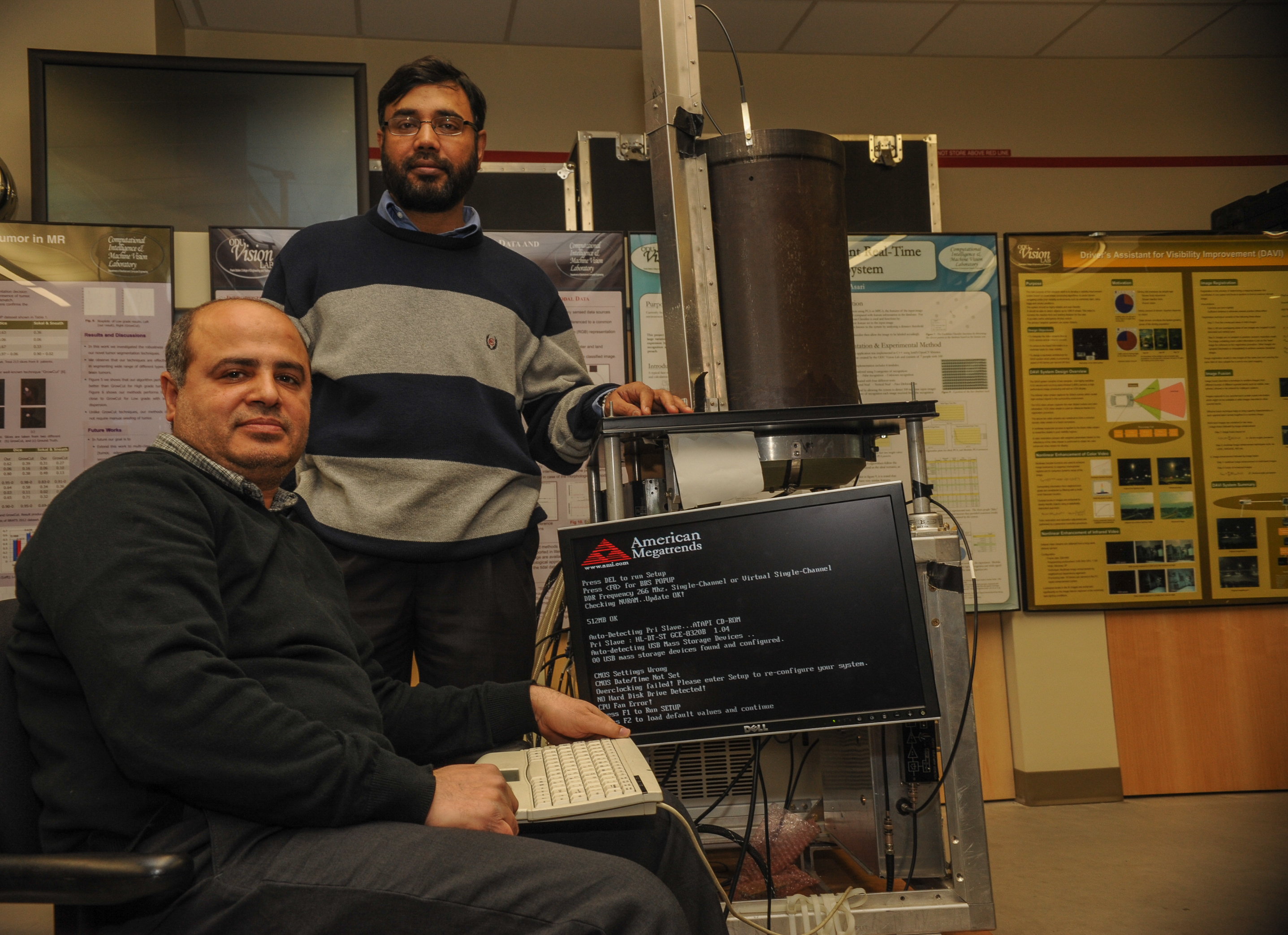Grant Will Help ODU Vision Lab, Transportation Research Institute Scientists Classify Airborne Pollutant Types
February 03, 2015
 Vision Lab director Khan Iftekharuddin (standing) and postdoctoral student Mohamed Elbakary with the LiDAR machine.
Vision Lab director Khan Iftekharuddin (standing) and postdoctoral student Mohamed Elbakary with the LiDAR machine.
Two years ago, researchers at Old Dominion University's Vision Lab received a $100,000 machine from NASA with the capability of simultaneously detecting levels of airborne pollutants at different altitudes.
Known as the NASA Aerosol LiDAR (light detection and ranging system), the machine does atmospheric profiling by emitting an infrared laser beam skyward. Vision Lab researchers utilized their groundbreaking computational vision technology to analyze vertical profiles of airborne pollutants.
Now, thanks to a $100,000 grant from the Mid-Atlantic Transportation Sustainability University Transportation Center (MATS UTC) funded by the United States Department of Transportation (USDOT), Vision Lab researchers will extend their exploratory study of airborne pollutant vertical profiles, to do more than detect the density of greenhouse gas particles in the air.
Advances in machine vision technology, plus greater knowledge of the formulation of different molecules, will allow ODU researchers to determine not only the level of airborne pollutants, but also determine which molecules are most prevalent.
As articulated in the U.S. Department of Transportation's strategic plan for 2012-2016, transportation systems have negative impacts on the environment and account for a significant share of greenhouse gas (GHG) and other harmful emissions.
The plan also states that, "As of 2007, some 158.5 million Americans lived in counties or regions that exceeded health-based, national ambient air quality standards for at least one regulated air pollutant." This research is focused on developing a unique LiDAR system for measuring air quality over a large area at high spatial resolution.
Khan Iftekharuddin, Vision Lab Director and chair of the Department of Electrical and Computer Engineering in ODU's Frank Batten College of Engineering and Technology, is principal investigator on the grant. His research collaborators on the project are Mecit Cetin, associate professor of civil and environmental engineering, and director of Old Dominion University's Transportation Research Institute, and Hesham Rakha of Virginia Tech.
The grant is part of a $750,000, multi-university MAT UTC initiative, led by UVA and includes ODU. The PIs of this grant are looking at airborne pollutants and other harmful emissions whereas the larger initiative supports various projects on sustainable transportation solutions. The LiDAR technology is unique because of its ability to take continuous measurements over a large vertical area at a high resolution. The machine itself is also portable. Approximately the size of a photocopy machine, the LiDAR can be moved to different locations around Hampton Roads, to determine which airborne pollutants appear in which density at chosen locations.
Researchers can determine if airborne activity near Virginia's coal ports results in a different vertical profile than the atmosphere near the highways, bridges and tunnels of Hampton Roads.
As compared to the alternative options, this LIDAR system allows taking continuous measurements for a long range simultaneously which is not available today with the alternative particulate matter (PM) measurement technologies.
Originally designed to be mounted on an aircraft, this compact, portable, airborne LiDAR was used in several field studies. It has been adapted for use by Vision Lab researchers on the ground, shooting the laser beam into the atmosphere. The purpose of this research project is to further enhance the capabilities of the LiDAR system, to incorporate measured air quality data into GIS, to accurately identify locations of high pollution areas.
The Vision Lab's work has been recognized by grant-funding agencies, particularly in the homeland security field, for several years. Researchers at the lab focus on developing new algorithms and architectures for real-time applications in the areas of signal processing, image processing, computer vision, pattern recognition and biologically inspired object recognition.
Recently, ODU researchers have applied their machine vision and computational intelligence research to the analysis of commercial products such as Google Glass, with an eye to improving performance capability of the innovative new tools.

